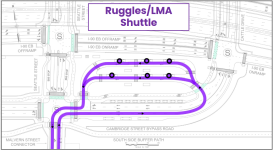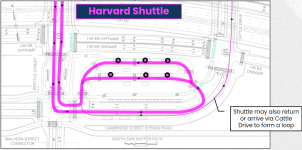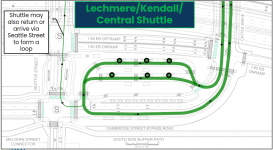I'd be stunned if the 64 and 66 weren't rerouted through West Station once it's built, and it is well within reason for even the 57 to get diverted.
The 66 was discussed at length over the last decade, and the T concluded that it would be much much too disruptive to divert a Key Route the degree to which it would have to divert to loop at West. The BNRD only reaffirmed that decision. There will never be a 66 stopping there. It's simply too load-bearing as a crosstown route to redraw to that degree, and upgrading it to a Frequent Route means the headway adherence is simply too important to ever risk. The T has pretty stiff standards for OTP on Key Routes and considers it a crisis if a Key Route is not meeting their weekday OTP. They will not be risking the 66's OTP. The 64...much poorer on schedule efficiency, frequency, and on-time performance...was controversial in its own diversion, because it already makes a serpentine route with a Boston Landing diversion and suffers from abysmal OTP overall. But it's something, I guess.
The 57??? That doesn't trace a corridor nearly close enough to West to do a punitive re-route. The 57 is one of the busiest buses on the whole system, and it narrowly avoids disastrous bunching with an OTP that's on-the-button at the minimum standard for Key Routes. That OTP tanks if you try to re-route it on the narrow BU street grid and looping around the block at West. Rest assured they will never consider that.
There are no other T buses within reach to draw here. Not now, and not likely ever. The 64 is it. And the 64 doesn't even use these busways because it has to stay on-street not loop to even have a puncher's chance at meeting its schedule.
Also, the highway reconfiguration will likely last for generations, especially if the decking plans go through. Who knows what bus demand or service will look like 50 years out, and building some extra capacity now is completely reasonable.
No, it's not. Not when the project is literally DROWNING in cost overruns and design decisions that don't fit. The excessive bus berths are just ONE symptom of the chaos that is threatening to tank this project. The whole station is going to need a serious VE'ing at both the upper and lower levels to work at any cost worth paying. When so-called "reasonable" extra capacity is a key contributor to netting a project that can't be built in any form, we all lose. The whole works is teetering on the brink of collapse. To un-teeter it, you must right-size. 10 berths vs. the still-excessive 6 in the previous render is going further in the wrong direction and pushing it ever harder towards collapse. Do we want a station that's usable in our lifetimes? If so, we have to rationalize some of these nonsensical decisions with...sensical-er decisions. Stat!
Do I think that's why the bus deck is getting built? No, this is almost certainly being done at the request of Harvard and business groups for their shuttles. Even if MassDOT is doing this for dubious reasons, a broken clock is at least right twice a day. Does that justify 10 berths? Probably not, but it certainly justifies some.
Harvard and the business groups can feel free to submit their service plans and future growth projections for using all the berths if they are "requesting" so many of them. They have all failed to do so. Based on route profiles of Harvard's other shuttles, the LMA shuttles, and the MIT/Kendall-institution shuttles...the math didn't add up before for 6 simultaneous berths, and that's all the information the state had for guessing at the number of berths. It didn't add up for 6, and it damn sure doesn't add up now for 10. So how many does it truly justify, so we can save this imploding project with a proper VE? Do any of the stakeholders even care enough to say? Doesn't appear so.



